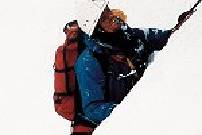|
|
||||
|
|
by Donald Levit  With often mediocre results, concentrating as they must, and should, on character and plot, mountaineering fiction-features do not quite bring home the full majesty of their settings. Thus, The White Tower, The Mountain, Five Days One Summer, The Eiger Sanction, K-2, Cliffhanger, Vertical Limit and others are hardly a patch on that granddaddy of documentaries on the theme, The Conquest of Everest. Happily, Academy Award-winning director Kevin Macdonald's Touching the Void manages a breakthrough, successfully juxtaposing and also melding the dangerous physical beauty of the world's highest peaks, with the real human drama and personal conflicts of those who dare them. That this project -- originally envisioned for television -- has finally been done at all is a feat, inasmuch as several other attempts never came to fruition, including Sally Field's Fogwood Films option for a Tom Cruise Hollywood vehicle from the Joe Simpson book of the same name. It was a blessing as much as disappointment that prior commitment prevented my attending a subsequent press session for Macdonald and Simpson. The screen experience is so complete in itself that, while providing additional perspective, questions-and-answers might even have clouded an already focused impression. Perhaps later, but not now. Then there are the dramatic chapters, major recreations in the Alps which are so captivating in their elemental beauty that the actual difficulty of making them easily passes unnoticed. Guide Brian Hall, Director of Photography Mike Eley and the crew dealt with seemingly impossible situations, as did Brendan Mackey (as Simpson) and Nicholas Aaron (as Yates), well chosen not for special physical resemblance to their originals but for their portrayals of emotional and psychological aspects. So seamlessly are interviews, acting and recreation brought together, that one forgets the amalgam in the integrated whole. The two climbers' experience had been Alpine and not Andean when in 1985 they approached the never climbed West Face of Peru's isolated, formidable Siula Grande. "Fairly irresponsible, we were," is a later assessment. "Fun, but every once in a while, it went terribly wrong; then it wasn't." It goes wrong as, in worse weather and physical condition than they had expected, they reach the summit (no one else has since) through powdery "mushrooms and meringues" of snow. That was the easy part. Eighty percent of climbing accidents occur on the descent, and in a storm whiteout, Simpson falls and shatters his lower right leg, driving it through the kneecap. At the risk of dooming them both, Simon ties and lowers his disabled companion, three hundred feet at a shot on their longest two ropes. With no food or water left, frostbitten in -80º windchill conditions, they continue until, visibility zero, the injured man slides over a precipice. After fighting the lifeline for an hour, close to his own end and believing his partner dead, Simon cuts the nylon cord and arduously makes it back to base camp. Alive, however, Joe miraculously falls onto a ledge inside a crevasse "as high as St. Paul's dome." The following dawn, in pain and despair he finds an eerie, icy way out and begins a delirious amazing three-and-a-half-day journey. Despite Richard's worry and insistence, Simon's confusion and sense of guilt and shame have kept them in camp longer that they should. (Simpson's best-selling book, in fact, is a defense of Yates against near unanimous condemnation by the world climbing community.) Along with the skilled photography, the setting and the integration of documentary technique with character, particularly interesting are the takes on life and death. For the void to be touched encompasses external space was well as internal. The crippled climber's will to "have things my way" alternates with moments of "having nothing, you're nothing, no dignity, you don't care [but] want to be with someone when I died." Such are likely the thoughts, too, of the gravely ill, of dying patients. At whatever level, Touching the Void is stirring and inspiring. Less than perfect, man does somehow survive; and he returns to climbing mountains. (From Darlow Smithson Productions; not rated by MPAA.) |
||
|
© 2025 - ReelTalk Movie Reviews Website designed by Dot Pitch Studios, LLC |



